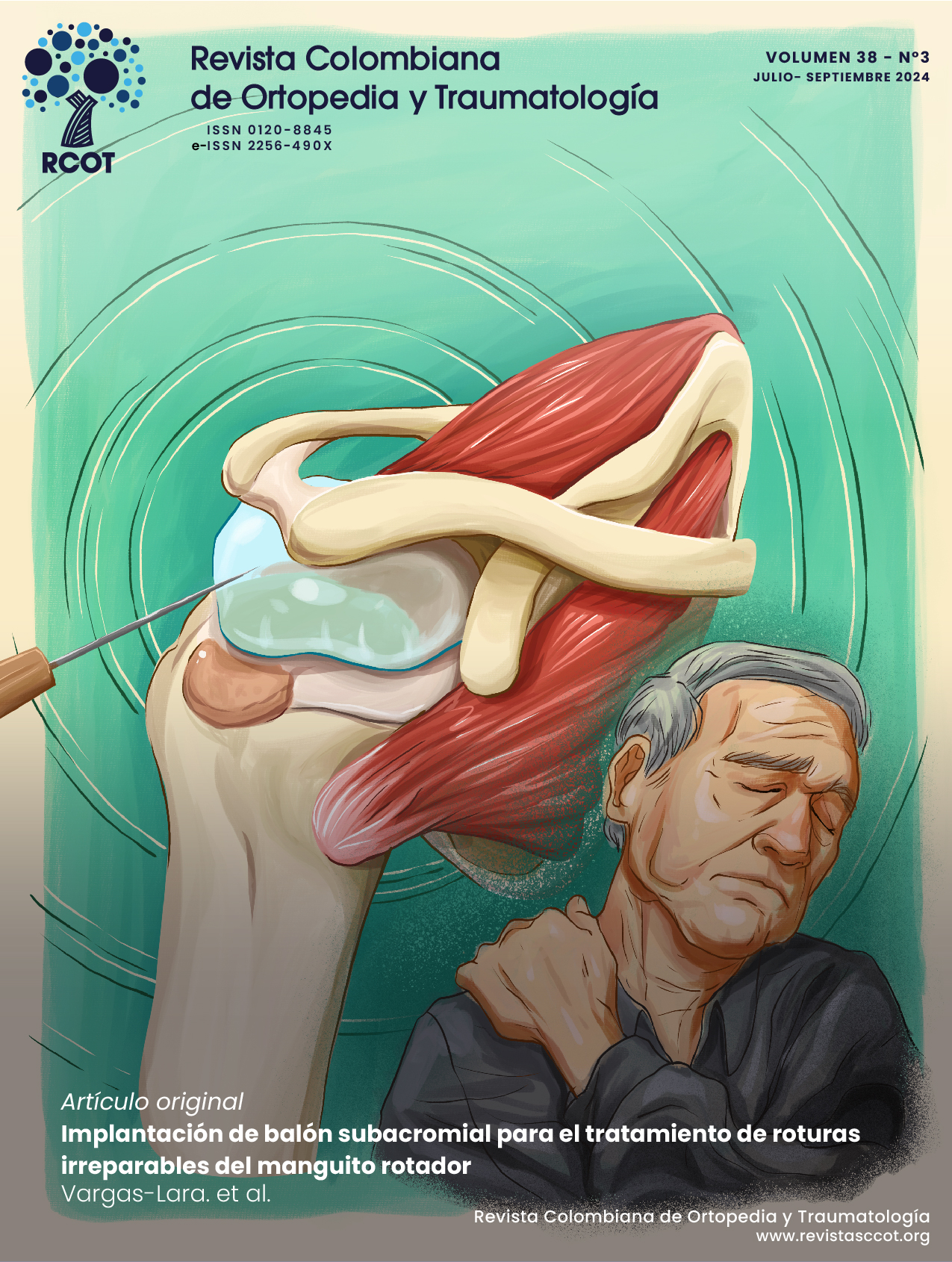Modified Masquelet technique for the reconstruction of a 16-centimeter femoral bone defect: a case report
DOI:
https://doi.org/10.58814/01208845.75Keywords:
Osteomyelitis, Femoral Fractures, Intramedullary Nailing, Bone Lengthening, Case ReportAbstract
Introduction: Multiple options exist for the surgical treatment of bone defects (BD). Although there is no consensus on the gold standard, the induced membrane technique (Masquelet) has demonstrated good functional outcomes and union rates, especially in femoral BDs.
Case presentation: In 1990, a 68-year-old man suffered diaphyseal fractures of the left femur and femoral neck. Two years after undergoing surgery to treat these fractures, he experienced several episodes of infection in the surgical wound and eventually in the bone for 17 years. In 2009, the patient presented to the emergency department of a tertiary care clinic in Bogotá D.C. (Colombia) due to left thigh pain and fistula with pus. He was admitted to the hospital and imaging and laboratory tests were performed, with findings suggesting chronic osteomyelitis. The patient was taken to a two-stage surgery in which the Masquelet technique was used (first stage: resection of the infected bone tissue [16cm] and stabilization with intramedullary nail plus bone cement spacer; second stage: use of structural allograft mixture of condyle for reconstructing the BD), achieving a satisfactory reconstruction of the BD and a significant improvement in functionality and long-term quality of life (last follow-up: 13 years after the reconstruction of the BD).
Conclusion: In the present case, the modified Masquelet technique allowed the reconstruction of a large BD, achieving good outcomes (recovery of function and significant improvement in quality of life). Moreover, the patient did not experience any complications associated with the procedure.
Downloads
References
Lashin AM, Mousa WF, Hosni MM, El-Forse E-S. Induced Membrane (Masquelet) Technique for Treatment of Long Bone Defects. Med J Cairo Univ. 2018;86:215-22. https://doi.org/m9n7.
Careri S, Vitiello R, Oliva MS, Ziranu A, Maccauro G, Perisano C. Masquelet technique and osteomyelitis: innovations and literature review. Eur Rev Med Pharmacol Sci. 2019;23(Suppl 2):210-6. https://doi.org/gpqg3h.
Ilizarov GA. The principles of the Ilizarov method. Bull Hosp Jt Dis Orthop Inst. 1988;48(1):1-11.
Masquelet AC, Fitoussi F, Begue T, Muller GP. Reconstruction des os longs par membrane induite et autogreffe spongieuse [Reconstruction of the long bones by the induced membrane and spongy autograft]. Ann Chir Plast Esthet. 2000;45(3):346-53.
Morelli I, Drago L, George DA, Gallazzi E, Scarponi S, Romanò CL. Masquelet technique: myth or reality? A systematic review and meta-analysis. Injury 2016;47(Suppl 6):S68-76. https://doi.org/f9zn2c.
Zhang H, Zhao X, Yang X, Zhang X, Chen X, Zhou T, et al. Comparison of internal and external fixation after debridement in the Masquelet technique for Cierny-Mader type IV tibial post-traumatic osteomyelitis. Injury. 2023;54(2):422-8. https://doi.org/m9n8.
Kalantar SH, Saffar H, Hoveidaei AH. Bone reconstruction with modified Masquelet technique in open distal femoral fractures: a case series. BMC Musculoskelet Disord. 2024;25(1):26. https://doi.org/m9n9.
Mukhopadhaya J, Gautam K, Bhadani JS. A case report of extensive segmental defect of the humerus due to thermal necrosis treated with Masquelet technique. Trauma Case Rep. 2021;36:100544. https://doi.org/m9pb.
Tong K, Zhong Z, Peng Y, Lin C, Cao S, Yang Y, et al. Masquelet technique versus Ilizarov bone transport for reconstruction of lower extremity bone defects following posttraumatic osteomyelitis. Injury. 2017;48(7):1616-22. https://doi.org/gbqpxt.
Wang P, Wu Y, Rui Y, Wang J, Liu J, Ma Y. Masquelet technique for reconstructing bone defects in open lower limb fracture: Analysis of the relationship between bone defect and bone graft. Injury. 2021;52(4):988-95. https://doi.org/m9pc.
Raven TF, Moghaddam A, Ermisch C, Westhauser F, Heller R, Bruckner T, et al. Use of Masquelet technique in treatment of septic and atrophic fracture nonunion. Injury 2019;50(Suppl 3):40-54. https://doi.org/gh6wt8.
Morwood MP, Streufert BD, Bauer A, Olinger C, Tobey D, Beebe M, et al. Intramedullary Nails Yield Superior Results Compared With Plate Fixation When Using the Masquelet Technique in the Femur and Tibia. J Orthop Trauma. 2019;33(11):547-52. https://doi.org/m9pd.
Ayouba G, Lemonne F, Kombate NK, Bakriga B, Yaovi Edem J, André-Pierre Max U. Interest of nailing associated with the Masquelet technique in reconstruction of bone defect. J Orthop. 2019;20:228-31. https://doi.org/m9pf.
Pesciallo CA, Garabano G, Dainotto T, Ernst G. Masquelet technique in post-traumatic infected femoral and tibial segmental bone defects. Union and reoperation rates with high proportions (up to 64%) of allograft in the second stage. Injury. 2021;52(11):3471-7. https://doi.org/m9pg.
Becker V, Nardone E, Robbins S, Anderson D, Maiman D, Fry M, et al. Comparison of autograft to DBX demineralized bone matrix putty combined with autograft used in posterolateral lumbar spinal fusion. The Spine Journal. 2005;5(Suppl 4):S56-7. https://doi.org/dkwj7g.
Cardona-Arias JA, Ospina-Franco LC, Eljadue-Alzamora AP. Validez discriminante, convergente/divergente, fiabilidad y consistencia interna, del WHOQOL-BREF y el MOSSF-36 en adultos sanos de un municipio colombiano. Rev. Fac. Nac. Salud Pública. 2015;33(1):50-7. https://doi.org/nhk3.
Downloads
Published
How to Cite
Issue
Section
License
Copyright (c) 2024 Revista Colombiana de ortopedia y traumatología

This work is licensed under a Creative Commons Attribution 3.0 Unported License.




